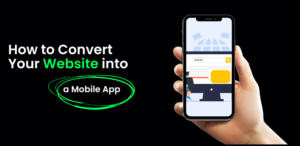The Ultimate Responsive Website Design Checklist

A website represents what you are as a brand. It is the face of your business. Thus, it is imperative to ensure a responsive web design to allow your users a seamless mobile view of website from any mobile device. Impeccable user experience is the first thing that helps a business reach its primary goal, that is, spreading the word out there. After all, better user engagement means more significant sales and higher revenue!

Source: Statista
Statista says that more than half of the queries come from mobile devices. There is also a 50.44% chance that you are reading this on your smartphone right now. This establishes the need to have a responsive web design even more urgent. But the real question is how to ensure that a website is responsive or that the users have the best mobile view of website. After all, you want to make the most out of your digital presence and that is what our focus will for today. I will be jotting everything you need to incorporate in your responsive design checklist.
What is Responsive Web Design and Why Is It Important?

The diversity of devices we are using to surf the internet is increasing. Earlier, it used to be the same old desktop computers all over the world. But with a tremendous increase in digitalization, the number of people using smartphones for browsing is on the rise. Plus, tablets, smartwatches, large screen smart TVs further prove how diverse the world of smart devices is becoming.
When a site has a responsive web design it looks great and retains all its functionalities across various viewport and screen resolutions. People use a wide array of devices to carry out their day to day interactions with web pages all over the internet. But if they’re not able to enjoy a seamless experience on all their devices, it can negatively impact the credibility of a business. To put it precisely, responsive web design is a mobile-friendly design or a mobile-first design. Moving on with our responsive design checklist, we will find out how you can avail the best mobile view of website for your users.
Presenting The Responsive Design Checklist
There are various aspects that play a crucial role in determining whether your site is responsive. Earlier, responsiveness used to be an additional feature. In other words, it was considered a privilege for users and a big deal for business a while back. However, times have changed and the internet world has evolved. This means that a responsive website has become a necessity if a business aims to succeed.
Coming to the modus operandi of transforming your existing website for responsive web design, there are certain tricks to do that.
How does one ensure a responsive web design?
- Start Optimization For Smaller Screen Size
First things first for this responsive design checklist. It is recommended to check the optimization of a site for small mobile devices first. After that, you can work on increasing compatibility with bigger display options. Even if you are planning to revamp a website, it’s better to follow a mobile-first approach. The reason most web designers and developers are following this approach is to avoid extra hassle.

Source: Giphy
For example, if you design on a larger space, it can be hard to compress or remove information later. Without a mobile-first approach, there are chances that the site can appear cramped if you try to display all the content. If you cut things out, the user won’t have a complete insight into what you’re offering.
- Testing A Website For Responsiveness
From checking the mobile view of a site, testing it on different devices, and inspecting the mobile view of any website on various iOS and Android devices, responsiveness testing covers it all. But doing this on devices of various resolutions and screen sizes can be an overwhelming task. How are you supposed to check your website on such a vast variety of devices used by the people around? Even if you somehow set up a huge concourse of real devices or emulators and simulators, what if you can’t find the device of your choice?
Well, if these are the pain points holding you back, LambdaTest has recently launched a new feature called LT Browser. Not only does it provide a side by side mobile view of website on multiple devices, but LT Browser also enables testers to create custom devices and test on them. Moreover, the in-built DevTools for simultaneously debugging multiple devices while responsiveness testing is a major added bonus. It also allows you to perform responsive testing of a locally hosted website.
- Check For Smooth Navigation
Next up in this responsive design checklist is navigation. It is a crucial pillar of a successful website. But, most businesses fail to render flawlessness in this area for the mobile version of a site. I’m going to explain this mistake through a relatable example. Even though you might have optimized the navigation elements well, sometimes, they can overlap the edges of the screen when a user views the site from a smartphone or tablet.

Source: Giphy
Also, users don’t like to zoom in and out too much. Swipe navigation with screen optimization is a way to ensure smoothness in navigation. A menu should expand once the user taps on it. This will save them the trouble of scrolling up and down or side to side. Plus, when users open a page, everything should be visible without any piece of text or image getting cut off.
You can define the scrolling experience by implementing either CSS smooth scroll, or you can go for CSS scroll snap if you want to enforce a specific scroll position.
- Test The Site For Interactivity
While considering mobile devices, the conventional mouse clicks are out of the window. Most viewers are likely to use a stylus if they are browsing on a tablet. As for smartphone users, finger taps are the way to go. You need to seek answers to some important questions before you give your site the green signal. For implementing this responsive design checklist, ask yourself these questions.
- Are the buttons large enough for a tablet stylus?
- Are the buttons large enough for tapping fingertips on a smartphone?
- Can users easily tap on the navigation bar and menus on different devices?
- Can users easily fill out forms with styluses or finger taps?
If even one of your answers to these questions is no, make sure your controls respond to different gestures. Sometimes, elements that are responsive through a mouse click don’t respond the same way to finger taps. Now imagine how a user would react to looking at different menus adorned on their screen only to have them doubt their phone’s touch screen! In the end, we all want users to have a flawless experience regardless of the device they use for browsing.
- Testing Across Different Browsers & Devices
It’s important to analyze the site behavior through cross browser testing on mobile browsers. This approach ensures the delivery of an optimum UX irrespective of the browser environment or device used for accessing a site. For instance, if your site works well on Chrome on a PC, it should render the same experience on the mobile view of website for that browser version. The same goes for other browsers along with separate browser versions.
Google Analytics can help you gain access to traffic data from the web and mobile. This way, you will gain an insight into the browsers and mobile devices users are using to access your site. It’s also essential to keep updating device browser combinations as they can easily go outdated as time passes. The new ones work more optimally as compared to the old ones.
- Prioritize Important Content Across All Devices
There is not enough content in the world to show users how beneficial your products or services are for them! We get it. You wish to get your word out in the open. But believe it or not, sometimes, there is a thing called ‘too much content’. If you have elaborate and detailed resources on your website, you might want to prioritize the information before springing it all on a small screen.

Source: Giphy
Even though every aspect of your site is important, something has got to gain prominence over others, right? The crucial part of this responsive design checklist to ensure that the content you assign the topmost priority is visible across all devices. Every site has supporting content that you can choose not to show on small devices. It would be better if you organize content according to its order of importance and priority beforehand.
- Perform Visibility Testing
You have to make sure that the alignment is proper among text, images, and controls. Overflowing edges are a strict no as it compromises the display of content. Remember, users should be able to scroll through and see your full website with ease across various devices.
On that note, here are some salient features to include in your responsive design checklist. You must cater to these for ensuring enhanced visibility.
- Images don’t take up the whole screen
- Menus not cut off
- Correct formatting of bulleted lists
- A neat, clean and organized look for tables
- Proper service lists
- Appropriate formatting of images, headings, and descriptions
- Effective and appealing forms
- Well-organized and simple to use shopping carts
As brutal as it sounds, it takes just a few seconds for users to form a firm opinion about your business through a site. Make sure you make this time worthwhile for users and bring your business some conversions!
- Check Fonts and Typography
The typography of the content has a major role to play in the responsiveness of a website. If the color scheme and style looks okay on PC, it doesn’t mean that it will look just the same on mobile devices as well. But on a responsive website, they appear the same as on a desktop. Therefore, you should always check the fonts and typography for consistency.
For instance, evaluate the fonts and check whether they are applicable across different devices and operating systems. The style-sheet of your website should have the default device font defined. When the fonts, color scheme, and typography has no discrepancy across any device, you can cross out this point of your responsive design checklist.
- Check The Loading Speed Of The Website
With such speedy advancement of digitization, people’s attention spans have been on the decline. They will not wait forever for your site to load. Users love to have a seamless experience and nothing is more annoying than having a staring contest with the screen waiting for a web page to load.
 Source: Giphy
Source: Giphy
Now, I’m sure you have added some precious resources on your websites. But’s what’s the point of having them if your viewers leave the page before they can even look at them? After all, what loads quickly on a PC might not do the same on a smaller device. You might need to compress more considerable resources and use caching to boost your site’s speed.
I have listed some possible reasons why your website might be running slow on mobile:
- Unresponsive site elements
- You haven’t condensed the images
- Cluttering in the code
- Excess of heavy multimedia elements such as videos or high-quality images
- Test Every Element As A Site Visitor
Now you’re almost done with checking your site for responsiveness. Last, but surely not the last resort in this responsive design checklist is to examine every element of your website as a user. Take some laps around the web pages to ensure that it’s appealing to you, in this case, the visitor. For a moment, forget that it’s your site and create an unbiased opinion from the end user’s perspective.
 Source: Giphy
Source: Giphy
Ask yourself the following set of questions:
- Can you easily submit a form without complicated steps?
- Can you quickly checkout without too many clicks and taps?
- Are all the navigation bar links working on your mobile device?
- Are various elements of product pages and blogs working fine?
If you answered yes to these and other similar questions, you’re good to go! Checking out your site in detail as a visitor eliminates the possibility of things falling through the cracks during responsive testing.
Wrapping It Up
Google has already rolled out mobile-first indexing for the whole web in March 2020. Therefore, providing users the ultimate value while they browse through their phones is no longer optional. The legibility and alignment of text have to be perfect. The readers shouldn’t have to zoom in and out while reading and filing information. They shouldn’t have to struggle with the elements on the navigation bar!
In short, anything beneath perfection is unacceptable. It’s high time the entire team realizes how much the responsiveness of a site impacts overall revenue. Furthermore, LambdaTest can assist you in performing browser compatibility testing to ensure you have a responsive web design on 2000+ browsers and operating systems! So, if you wish to make your business reach the peak of success, quit cutting yourselves slack in this area and follow everything in this responsive design checklist.
Happy testing!






